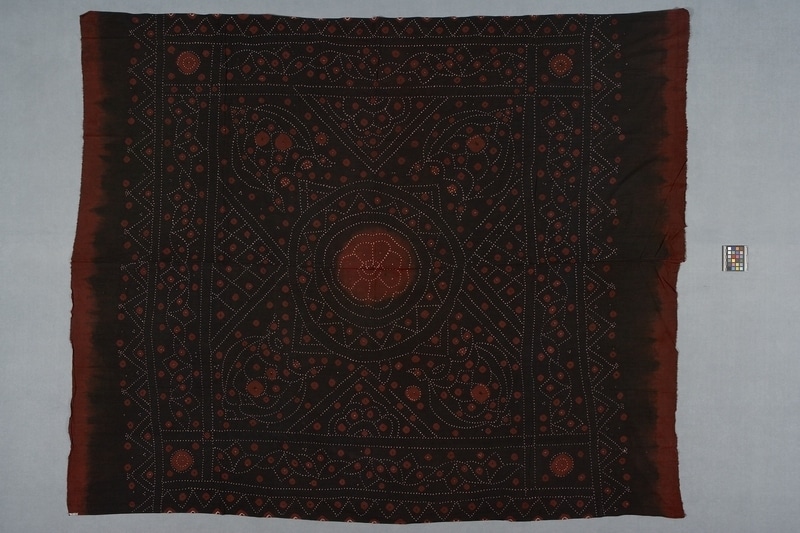Veil Item Number: 1472/6 b from the MOA: University of British Columbia

Description
Woman’s dark red and black, tie-dyed, cotton veil; decorated with off-white tie-dyed dots that form geometric, linear and curvilinear patterns. In the centre is a round black medallion within a square, dark red panel; there are black borders on all four sides. The veil is constructed from two nearly-identical sections that are seamed together down the centre with machine stitching.
History Of Use
To be worn with a matching skirt (1472/6 a) and a backless blouse (choli or kancheeri), along with ivory or white plastic bracelets covering the upper and lower arms, as wedding attire by brides who are members of a particular caste. Subtle differences in design, colour and pattern occur among different villages. A women purchases the skirt and veil from a printer for her daughter’s wedding.
Cultural Context
ceremonial
Iconographic Meaning
The colour red symbolizes blood and life. It is associated with weddings and is always included in dowry garments. There are references to tie-dyed cloth as symbolic of fidelity in Sindhi folk poetry.
Specific Techniques
Bandhani means “to tie.” Before dyeing, the textile is printed with the design using a wooden block and a temporary dye that washes out. A continuous string, which has been dipped in wax, is used to firmly tie all the pattern elements on the piece before dyeing. After dyeing and washing, the string is removed.
Item History
- Made in Khipro, Sindh, Pakistan
- Collected by Razia Ahmed during 1979
- Owned by Razia Ahmed before March 18, 1991
- Received from Razia Ahmed (Seller) and Museum of Anthropology Shop Volunteers (Funding source) on March 18, 1991
What
- Name
- Veil
- Identification Number
- 1472/6 b
- Type of Item
- veil
- Material
- cotton fibre and dye
- Manufacturing Technique
- tie-dyed and sewn
- Overall
- height 201.8 cm, width 169.7 cm
Who
- Culture
- Rabari ?
- Field Collector
- Razia Ahmed
- Previous Owner
- Razia Ahmed
- Received from
- Razia Ahmed (Seller) and Museum of Anthropology Shop Volunteers (Funding source)
Where
- Holding Institution
- MOA: University of British Columbia
- Made in
- Khipro, Sindh, Pakistan
When
- Collection Date
- during 1979
- Ownership Date
- before March 18, 1991
- Acquisition Date
- on March 18, 1991
Other
- Item Classes
- textiles
- Condition
- good
- Accession Number
- 1472/0006 b